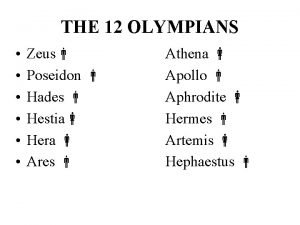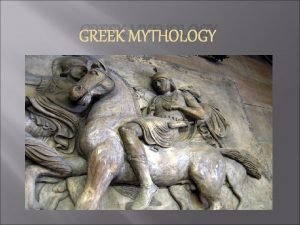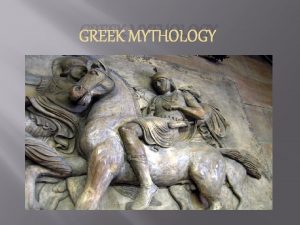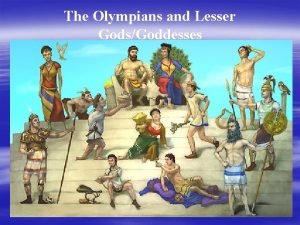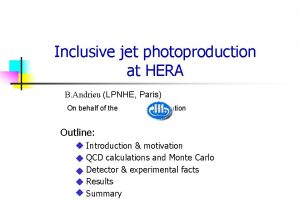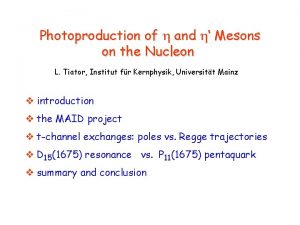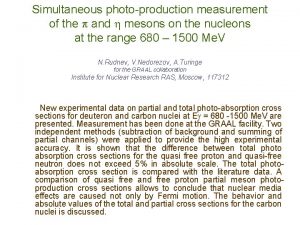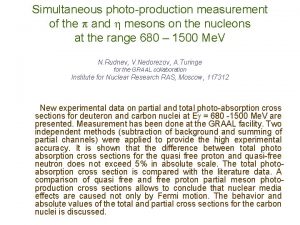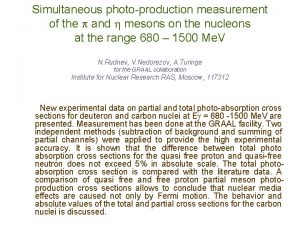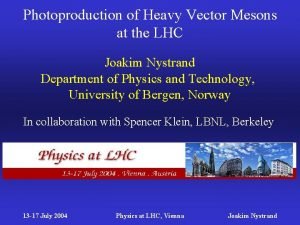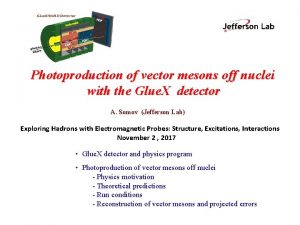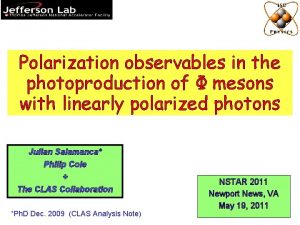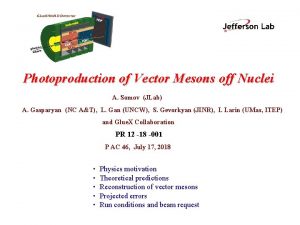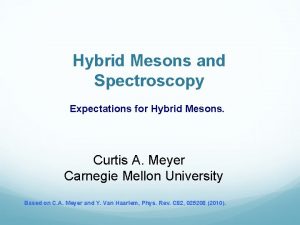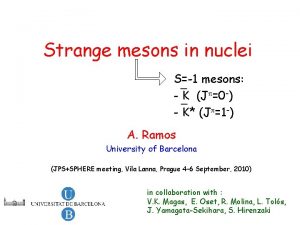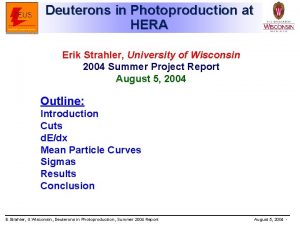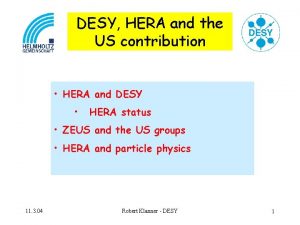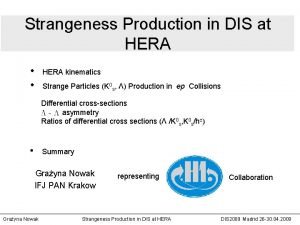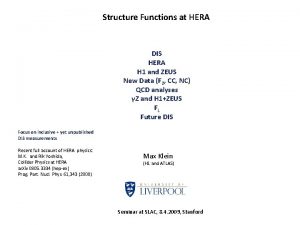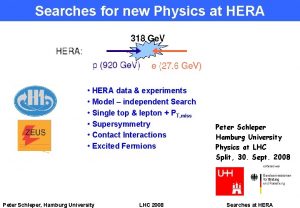Inclusive Photoproduction of K and Mesons at HERA


















- Slides: 18

Inclusive Photoproduction of ρº, K*º and φ Mesons at HERA Andrei Rostovtsev (ITEP) on behalf of H 1 Collaboration Published in H 1 Collab. , Phys. Lett. B 673, 119 -126 ICHEP 2010, 23 d July, Paris 1

ep kinematics -Q 2 x. Bj W energy c. m. : √s = 300 -320 Ge. V hadronic energy: W = m( *p) photon virtuality : Q 2 two regions: Q 2 ≈ 0 Ge. V 2 ― photoproduction Q 2 > 1 Ge. V 2 ― electroproduction (DIS) 2

Motivation collisions at LEP: distortion of ρ0 line shape and shift towards lower masses was observed • RHIC: inclusive ρ(770)0, K*(892)0 and φ(1020) ≈ co m e pl p (Au) W p ~ 210 Ge. V e e’ e x p (Au) • H 1: m pl √s. NN ~ 200 Ge. V e p si • √s ~ 90 Ge. V e+ e + e- give a unique opportunity to make comparison of RHIC results with simpler interaction system (HERA) , K*0(892), (1020) measurements at HERA help to study hadronisation 3

Selection e p e’ ET Main selection criteria for event: • H 1 data 2000 with L = 36. 5 pb-1 • Photoproduction Q 2 < 0. 01 Ge. V 2 with e’ in ET (electron tagger) • 174 < W < 256 Ge. V <W> = 210 Ge. V • Trigger requires at least 3 tracks in the Central Tracker with p. T > 0. 4 Ge. V ρ0 + - K*0 Kπ K K 4

0, K* and signal Fit function: F(m) = S(m) + R(m) + B(m) Signal Reflection Comb. background Clear signals of 0, K* and mesons are observed 5

Bose-Einstein Correlations (BEC) BEC effect 0 + + + e - + p unlike-sign — like-sign distortion of ρ0 mass spectrum due to BEC ρ0 signal A modification of 0 signal produced in p collisions is described by taking into account Bose-Einstein correlations in Monte Carlo 6

0, K* and : cross section measurement Q 2 < 0. 01 Ge. V 2 && 174 < W < 256 Ge. V, p. T > 0. 5 Ge. V && |ylab| < 1: σ pvis( p → ρ0 X) = 25600 ± 1800 ± 2700 nb σ pvis( p → K*0 X) = 6260 ± 350 ± 860 nb σ pvis( p → X) = 2400 ± 180 ± 340 nb 7

Hadron photoproduction at H 1 All inclusive photoproduction cross sections measured at H 1 are described by power law distribution with the same n = 6. 7 calculated from charged hadrons 8

0, K* and : cross section PHOJET 10: Dual Parton Model PYTHIA 6. 2: LO QCD ME with a very low p. T cut-off and PS • invariant differential cross section can be described by power law distribution • within rapidity range, the meson production rates are constant as a function of rapidity (within errors) • PYTHIA and PHOJET models do not describe the shape of the measured p. T spectrum 9

0, K* and : power law distribution p. QCD Thermodynamic model is extrapolated cross section in all p. T range 10

0, K* and : cross section fit parameters ET 0/n = • 0, K* and are produced with about the same value of the average <E Tkin> supports a thermodynamic picture of hadronic interactions • n is described by Monte Carlo while T is not (non p. QCD) • <p. T> in H 1 is in agreement with RHIC pp and is lower than RHIC Au. Au 11 A. Kropivnitskaya Light Mesons in Photoproduction DIS 2009

0, K* and : comparison with RHIC d. N/dy * 1000 p (H 1) pp(STAR) 0 K* 236± 30 259± 40 52± 7 51± 7 18± 3 18± 1 Remarkable agreement between production rates in pp and photoproduction The ratio of the production cross-sections R( /K*) measured in p is in agreement with pp results and below that for Au. Au measured at about the same collision energy at RHIC 12

Summary Light (770)0, K*(892)0 and (1020) mesons photoproduction at HERA: • first measurement in photoproduction at HERA • the description of the ρ0 shape of the meson is improved by taking Bose-Einstein correlations into account • p. T-spectra are described by power law distribution • 0, K* and are produced with about the same value of <ETkin> support a thermodynamic picture of hadronic interactions • comparison with RHIC results • The ratio of the production cross-sections R( /K*) measured in p is in agreement with pp results at about the same collision energy at RHIC • Some tendency for meson production to be more abundant in Au-Au collisions is observed • universality in p. T-spectra of hadrons at H 1 is observed 13

Back up 14

0, K* and : visible kinematical range All mesons are analyzed in following: - |y|< 1 in 7 p. T bins: 1 bin 2 bin 3 bin 4 bin 5 bin 6 bin 7 bin 0. 5 -0. 75 -1. 1. -1. 5 -2. 2. -3. 3. -4. 4. -7. Ge. V Extra cuts for mesons: K*0: 1 bin: Kaon d. E/dx ident. && cos * < 0; 2 -3 bin: Kaon d. E/dx ident. : 1 -3 bin: Kaon d. E/dx identification bin p. T: 0. -0. 25 Ge. V is excluded due to non description DATA and MC bin p. T: 0. 25 -0. 5 Ge. V is excluded due to big Background for K* 0 and small meson reconstructed efficiency - p. T > 0. 5 Ge. V in 4 y bins: 1 bin 2 bin 3 bin 4 bin -1. : -0. 5 -0. 0. -0. 5 -1. Extra cuts for mesons: K*0: 1 -4 bin: Kaon d. E/dx ident. && cos * < 0 : 1 -4 bin: Kaon d. E/dx identification y – rapidity of mesons p. T – transverse momentum of mesons polarization + K*0 15

Fit Procedure ρ 0 + Fit function: K*0 Kπ K K F(m) = S(m) + R(m) + B(m) Signal S(m) = convolution of BW(m) and res(m, m’) rel. Breit-Wigner BW(m) = Amm 0Γ(m)/[(m 2 -m 02)2 +m 02Γ 2(m)] Γ(m) =Γ 0(q/q 0)2 l+1 m 0/m resolution function res(m, m’) = 1/[2 p] • Γres/[(m-m’)2 +(Γ res/2)2] reflection R(m): for ρ0: for K*0 : for : K*0 Kπ and ω + -(π0) ρ0 + -, ω + -(π0), K K and self-reflection K*0 Kπ — combinatorial background B(m): for ρ0 and K*0: B(m) = {M(π±π±) or M(K±π±) )} • {Pol(2 -3) or (a 1+a 2 • x) • exp(-a 3 • x-a 4 • x 2)} for : B(m) = b 1 • (m 2 – 4 m. K 2)b 2 • exp(-b 3 • m) 16

0, K* and : cross section calculation Invariant differential cross section: Differential cross section: N – number of mesons from fit ∆p. T 2 and ∆ylab – bin widths L = 36. 5 pb-1 = 0. 0127 – photon flux BR = 1. for 0, 0. 67 for K*0 and 0. 49 for rec • Aetag • A 3 • trig efficiency reconstruction efficiency for the meson rec varies from 45% to 90% (using Monte Carlo) positron tagger acceptance Aetag = 48. 5% trigger acceptance A 3 varies from 50% to 95% (using Monte Carlo) trigger efficiency trig ~ 90% (using Monitor Triggers) 17

The HERA Collider p e± 27. 5 Ge. V 820, 920 Ge. V p ZEUS H 1 HERA e H 1 and ZEUS: - 92 - 07 years - Lumi ~ 0. 5 fb-1 (each exper. ) 18
 Hestia epithets
Hestia epithets Zeus's strengths
Zeus's strengths What is aphrodite's roman name
What is aphrodite's roman name Hera and zeus kids
Hera and zeus kids Demeter realm
Demeter realm Greek vs roman gods
Greek vs roman gods Athena roman name
Athena roman name Prometheus background
Prometheus background Reimigining disability and inclusive education
Reimigining disability and inclusive education Inclusive exclusive math
Inclusive exclusive math Reimigining disability and inclusive education
Reimigining disability and inclusive education Ontario's equity and inclusive education strategy
Ontario's equity and inclusive education strategy Probability mutually exclusive
Probability mutually exclusive P(a and b) formula
P(a and b) formula Inclusive education and community partnership
Inclusive education and community partnership Aims and objectives of inclusive education
Aims and objectives of inclusive education Miguel lopez melero
Miguel lopez melero Persepine
Persepine Ares god of war characteristics
Ares god of war characteristics
